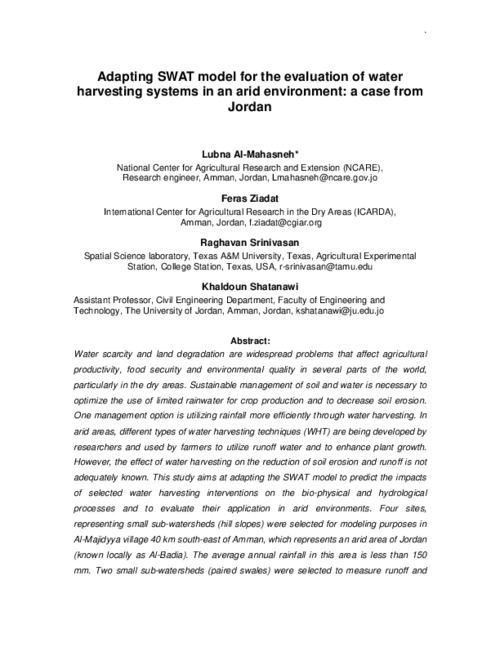Resource information
Water scarcity and land degradation are widespread problems that affect agricultural productivity, food security and environmental quality in several parts of the world, particularly in the dry areas. Sustainable management of soil and water is necessary to optimize the use of limited rainwater for crop production and to decrease soil erosion. One management option is utilizing rainfall more efficiently through water harvesting. In arid areas, different types of water harvesting techniques (WHT) are being developed by
researchers and used by farmers to utilize runoff water and to enhance plant growth. However, the effect of water harvesting on the reduction of soil erosion and runoff is not adequately known. This study aims at adapting the SWAT model to predict the impacts of selected water harvesting interventions on the bio-physical and hydrological processes and to evaluate their application in arid environments. Four sites,
representing small sub-watersheds (hill slopes) were selected for modeling purposes in Al-Majidyya village 40 km south-east of Amman, which represents an arid area of Jordan (known locally as Al-Badia). The average annual rainfall in this area is less than 150 mm. Two small sub-watersheds (paired swales) were selected to measure runoff and erosion, using flow meters and ISCO automatic samplers. One of these swales has been treated using Vallerani plough to form intermittent pits to collect and store runoff water.
This swale was planted by Salsola vermiculata shrubs and the other swale has been left without any intervention (control representing the natural rangelands in the area). The other two small sub-watersheds (paired swales) were selected to measure sediment yield only using geo-textile trap. One of these paired swales contains continuous contour ridges as water harvesting measure and was planted with Atriplex halimus shrubs while the other sub-watershed was left without intervention and planted with Barley (Hordeum vulgare), representing the farmer practices. The model input parameters were derived
using the SWAT ArcGIS Interface. Some parameters (Leaf Area Index and Harvest Index) for plant growth were modified to suit the prevailing arid conditions in the watersheds. Many iterations were carried out by introducing different management options in SWAT databases taking into account the subbasin, HRU and curve number values. The model overestimated the runoff and sediment yield from the water harvesting sites and to large extent accurately estimated for the sites without interventions. For example, the sediment yield predicted for the continuous contour ridges for a selected storm was 0.09 t/ha whereas no sediments were observed in the field. The predicted sediment yield for the barley site was 0.55 t/ha and the observed value was 0.34 t/ha. Manual calibration/comparisons for measured and observed results
are needed to adapt the model for this arid environment and to accurately estimate the effect of water harvesting interventions. In addition the comparison of biomass and crop yield will also be analyzed between observed and SWAT predicted outputs.


